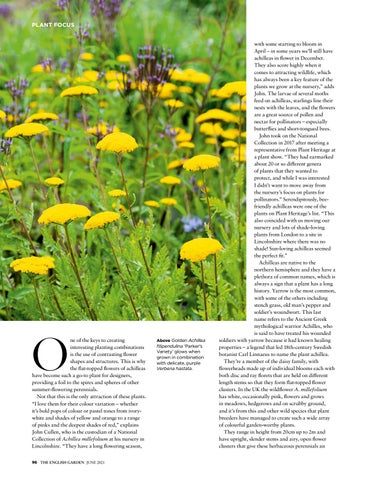PLANT FOCUS
O
ne of the keys to creating interesting planting combinations is the use of contrasting flower shapes and structures. This is why the flat-topped flowers of achilleas have become such a go-to plant for designers, providing a foil to the spires and spheres of other summer-flowering perennials. Not that this is the only attraction of these plants. “I love them for their colour variation – whether it’s bold pops of colour or pastel tones from ivorywhite and shades of yellow and orange to a range of pinks and the deepest shades of red,” explains John Cullen, who is the custodian of a National Collection of Achillea millefolium at his nursery in Lincolnshire. “They have a long flowering season, 96 THE ENGLISH GARDEN JUNE 2021
Above Golden Achillea
filipendulina ‘Parker’s Variety’ glows when grown in combination with delicate, purple Verbena hastata.
with some starting to bloom in April – in some years we’ll still have achilleas in flower in December. They also score highly when it comes to attracting wildlife, which has always been a key feature of the plants we grow at the nursery,” adds John. The larvae of several moths feed on achilleas, starlings line their nests with the leaves, and the flowers are a great source of pollen and nectar for pollinators – especially butterflies and short-tongued bees. John took on the National Collection in 2017 after meeting a representative from Plant Heritage at a plant show. “They had earmarked about 20 or so different genera of plants that they wanted to protect, and while I was interested I didn’t want to move away from the nursery’s focus on plants for pollinators.” Serendipitously, beefriendly achilleas were one of the plants on Plant Heritage’s list. “This also coincided with us moving our nursery and lots of shade-loving plants from London to a site in Lincolnshire where there was no shade! Sun-loving achilleas seemed the perfect fit.” Achilleas are native to the northern hemisphere and they have a plethora of common names, which is always a sign that a plant has a long history. Yarrow is the most common, with some of the others including stench grass, old man’s pepper and soldier’s woundwort. This last name refers to the Ancient Greek mythological warrior Achilles, who is said to have treated his wounded soldiers with yarrow because it had known healing properties – a legend that led 18th-century Swedish botanist Carl Linnaeus to name the plant achillea. They’re a member of the daisy family, with flowerheads made up of individual blooms each with both disc and ray florets that are held on different length stems so that they form flat-topped flower clusters. In the UK the wildflower A. millefolium has white, occasionally pink, flowers and grows in meadows, hedgerows and on scrubby ground, and it’s from this and other wild species that plant breeders have managed to create such a wide array of colourful garden-worthy plants. They range in height from 20cm up to 2m and have upright, slender stems and airy, open flower clusters that give these herbaceous perennials an












